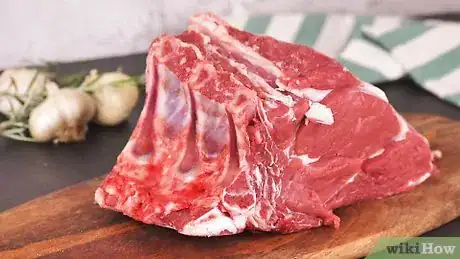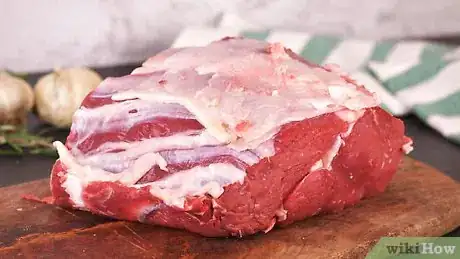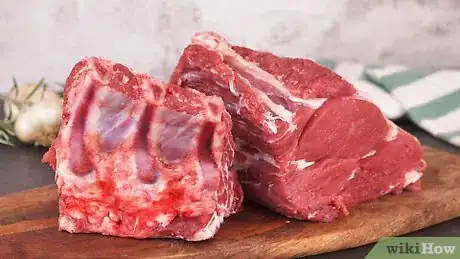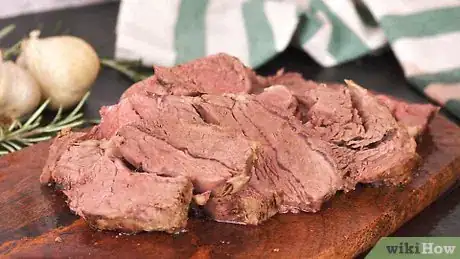This article was co-authored by wikiHow staff writer, Jessica Gibson. Jessica Gibson is a Writer and Editor who's been with wikiHow since 2014. After completing a year of art studies at the Emily Carr University in Vancouver, she graduated from Columbia College with a BA in History. Jessica also completed an MA in History from The University of Oregon in 2013.
The wikiHow Culinary Team also followed the article's instructions and verified that they work.
This article has been viewed 34,330 times.
Learn more...
Prime rib is a great meat to cut yourself. Purchase a large primal cut from your butcher and cut a prime rib roast according to the size you need. Once you have a prime rib roast, cut individual ribeye steaks. Decide if you'd like to keep the bones in or remove them. It's also important to learn how to carve a cooked prime rib roast so the meat stays warm and the slices are presentable.
Steps
Butchering a Prime Rib Roast
-
1Decide which end of the primal cut to use. Get out your large primal cut and place it on a large cutting board. One end of the cut should be slightly thinner and leaner. This is the single eye end of the cut. The other thicker end will be larger and have more fat running through it.[1]
- While you can use either end of the cut, consider using the smaller end if you're serving fewer people or want a leaner roast. If you're serving a crowd, you may want a roast that includes more of the larger end.
- You'll also need to decide how many rib bones to include in your roast. For example, to feed a large number of people, consider cutting a 5 rib roast.
-
2Cut along the bone to create the prime rib roast. Take a sharp knife that's at least 10 inches (25 cm) long and make a long, deep cut into the meat. Make the cut parallel to the rib bones so you don't cut into the bones.
- Try to make an even cut so the roast doesn't have a jagged or rough edge.
Advertisement -
3Trim off any sinewy bits. Look at the edges of the roast for bits of fat or muscles that are hanging off. Use your knife to cut these away. Take care not to cut deeply into the fat or muscle of the roast.[2]
- If you leave strands of the sinew, they may become tough as the roast cooks.
-
4Store or cook the prime rib roast. If you want to store the roast for later, wrap it tightly in plastic wrap and then place it in an airtight container. Refrigerate the roast for up to 3 to 5 days. To simply prepare the roast, sear the sides in a skillet until the meat is browned. Then finish roasting the meat in the oven until it's as cooked as you like.[3]
- Refrigerate leftover cooked roast in an airtight container for up to 3 to 5 days.
Cutting Ribeye Steaks
-
1Cut away the bones if you want boneless steaks. Set the prime rib on the cutting board so the bones point up. Keep a firm grip on the bones with one hand and use your knife to slice the meat next to the bone so it follows the curve. Then cut away the meat near the base where the bones are connected.
- You should now be able to pull away the bones and cut the meat into steaks.
-
2Decide how thick you'd like to make the steaks. Steak thickness is a matter of personal preference, so think about how thick you'd like them and how you plan on cooking them. Keep in mind that thicker steaks will probably need to be grilled longer or finished in the oven in order to cook completely.
- Most ribeye steaks are cut between 2 inches (5.1 cm) and 3 inches (7.6 cm) thick.
-
3Slice between the bones to make individual steaks. If you're leaving the bones in the prime rib, take a sharp knife and cut down between each bone. You'll have less control over how thick the steaks are because you'll just have to cut evenly between the bones.
- If you're cutting a boneless prime rib, lay a ruler down so you can measure how thick the steaks will be.
-
4Refrigerate or use the ribeye steaks. If you want to use the steaks later, wrap them individually in plastic wrap and put them in an airtight container. Refrigerate them for up to 3 to 5 days. To cook the steaks, decide if you want to toss them on the grill or cook them on the stove top.
- Refrigerate the leftover cooked steak in an airtight container for up to 3 to 5 days.
Carving Cooked Prime Rib
-
1Hold the bones and cut between the bones and the meat. Place the prime rib roast on a cutting board so the bones are pointing up. Hold the bones with one hand and use the knife in your other hand to cut down in a curve between the bones and the meat.[4]
- Use a long, thin-bladed knife to make it easier to slice the meat. Never use a serrated knife which could tear the meat as you're cutting.
-
2Fold the bones back and cut them away. Bend the bones back and away from the meat so you can see where they're loosely connected to the base of the roast. Then slice through the connection near the bottom so you can pull the bones away.[5]
- You should now have a large block of boneless prime rib that's ready to be sliced.
-
3Decide if you want to trim away excess fat. If you prefer leaner prime rib, take your knife and cut away the fat that's visible on the roast. If you're serving guests and aren't sure if they enjoy the fat, you may want to leave it so they can decide for themselves.[6]
-
4Cut the prime rib into 1/2 in (1.3 cm) thick slices. Hold the meat firmly in place using one hand and hold the carving knife with the other. Cut steady, even slices through the meat so you get pieces that are 1/2 in (1.3 cm) thick. Try to make gentle, even slices so it doesn't tear the meat as it's cut.[7]
- If you use a sawing motion to carve the prime rib, you'll get jagged slices of meat that don't look as pleasing.
-
5Avoid carving more slices than you need. Plan on carving enough slices to serve each of your guests once. Leave the rest of the roast on the cutting board so the meat stays warm longer. Then you can slice more servings as needed or store the meat for later.[8]
- To store leftover prime rib, put it in an airtight container and keep it in the refrigerator for up to 3 to 4 days.
Things You'll Need
- Sharp knife
- Cutting board
- Airtight storage containers
- Plastic wrap
References
- ↑ https://whatscookingamerica.net/EricTurner/PrimeRibRoast.htm
- ↑ https://youtu.be/YIoF39grUPw?t=475
- ↑ https://www.stilltasty.com/fooditems/index/16496
- ↑ https://www.seriouseats.com/2012/12/how-to-carve-a-prime-rib-slideshow.html
- ↑ https://www.seriouseats.com/2012/12/how-to-carve-a-prime-rib-slideshow.html
- ↑ https://www.seriouseats.com/2012/12/how-to-carve-a-prime-rib-slideshow.html
- ↑ https://www.seriouseats.com/2012/12/how-to-carve-a-prime-rib-slideshow.html
- ↑ https://www.seriouseats.com/2012/12/how-to-carve-a-prime-rib-slideshow.html
About This Article
Before cutting a prime rib roast from a primal cut, note that one end of the cut will be thinner and leaner and the other end will be thicker and have more fat running through it. If you plan to serve fewer people or want a leaner roast, cut your roast from the smaller side. However, if you’re serving a crowd, use the larger end. When you’re ready, use a sharp knife to make a long, deep cut into the meat that’s parallel to the rib bones. After cutting your roast, look at the edges for bits of fat or muscle that are hanging off and cut them away. To learn how to cut ribeye steaks, keep reading!





















































